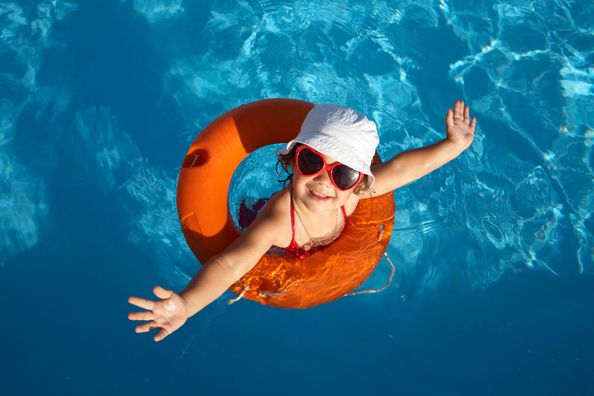“Cannonball!”
If you’re trying to stay cool — and keep your kids entertained — water activities are probably a key part of your summer routine and a great way to create lasting memories and fun for the whole family.
But while your kids are seeing who can do the coolest jump into the water, they may not be thinking about things like sun protection or staying in the shallow end.
If swimming is on your list of fun things to do this summer, then swim safety should be, too.
Here are 5 swim safety tips to ensure your day in the water is enjoyable for the whole family.
1. Keep an Eye on All Water Activities
There are many activities that kids can do unsupervised. Playing a board game or reading a book are great ways your kids can entertain themselves with minimal adult supervision. While many activities are good for kids to do on their own, swimming is not one of them.
There should always be a designated adult to actively watch children who are swimming in the water.
One of the best ways to keep your children safe this summer while in the water is to make sure they have the proper supervision. When possible, encourage children to swim where there is a lifeguard on duty and in areas marked for safe swimming.
2. Wear the Proper Attire and Flotation Devices
When you ride a bike, you wear a helmet, and when you drive in a car, you wear a seatbelt. In the same way, when doing water activities, safety gear is key. For example, depending on the activity, location, and your child’s swimming ability — wearing a personal flotation device, like a life jacket, might be recommended.
Who Should Wear a Personal Flotation Device — And When?
- Children (and adults) who are not strong swimmers
- Everyone — regardless of age — when on a boat
There are many different types of personal flotation devices, and they don’t all provide the same level of safety. In fact, what many people might automatically think of — water wings or “pool floaties” — are actually not the safest option and are not approved by the U.S. Coast Guard. Coast Guard-approved life jackets are the best option and should be matched with appropriate adult supervision.
In addition to a personal flotation device, other protective gear can help your children have fun while in, on, or near the water. Sunglasses and goggles can help protect their eyes, and water shoes can help protect their feet.
3. Enroll Your Kids in Swimming Classes
While personal flotation devices are essential to keep your child safe in the water, they are not a replacement for knowing how to swim.
According to the American Academy of Pediatrics, swim safety reports show that formal swim lessons for children 1 year and older reduce the risk of drowning — which is the number one cause of injury-related death for children ages 1 to 4. In fact, children can be enrolled in swim classes as early as just one year old.
Swimming lessons can help young children know how to tread water, float, and find an exit point from the water — all crucial swimming skills. Not only can swimming lessons make children more confident in the water and provide some peace of mind for you right now, but these skills will last them all their lives.
4. Be Your Best Lifeguard
You may think you have to be a lifeguard to benefit from water safety training. In fact, different courses can be beneficial for anyone who works in, plays in, or just loves the water. No one wants to experience a water-related accident — but having the skills to respond if you do can make a big difference.
To help you brush up on your own water safety, consider taking a local lifeguard, water safety, CPR, or swimming class for yourself. This can help you feel more confident in your own abilities — and your ability to help others in case of a water-related emergency.
The American Red Cross offers lifeguard certification and water safety certification year-round at locations all across the country.
5. Don’t Forget Sun Safety!
When thinking about water safety, it’s not just the water you need to consider, but the sun, too. Spending a long day in the water can feel refreshing and fun… until you come home to a painful sunburn.
UV rays from the sun can be damaging to your skin — both in the short-term (like a sunburn) or in the long run (like with skin cancer). In fact, 20% of Americans receive a diagnosis of skin cancer by their 70th birthday. But protecting your skin is easy to do from a young age and throughout your child’s entire life.
Wearing at least SPF 30 sunscreen — and reapplying at least every 2 hours — can protect your child’s skin and keep them safe and healthy during a long day in the water and sun.
Make a Splash With Swim Safety
As an adult, swim safety might be second nature for you. You may know how to float on your back or how to tread water — and you probably don’t need someone to remind you not to dive into the shallow end of the pool.
While swim safety tips may be just another part of your summer routine, it takes time for children to learn and remember these lessons. That’s why it’s not only important to practice safe water habits but to talk about them, too.
What might be the hundredth reminder to wear a life jacket today, can be the reminder that keeps your child safe for the rest of their life.
No matter the weather and no matter the season, Duly Health and Care is here for your family. Find a pediatrician near you, or call your preferred location to meet with a provider today.
Health Topics:







